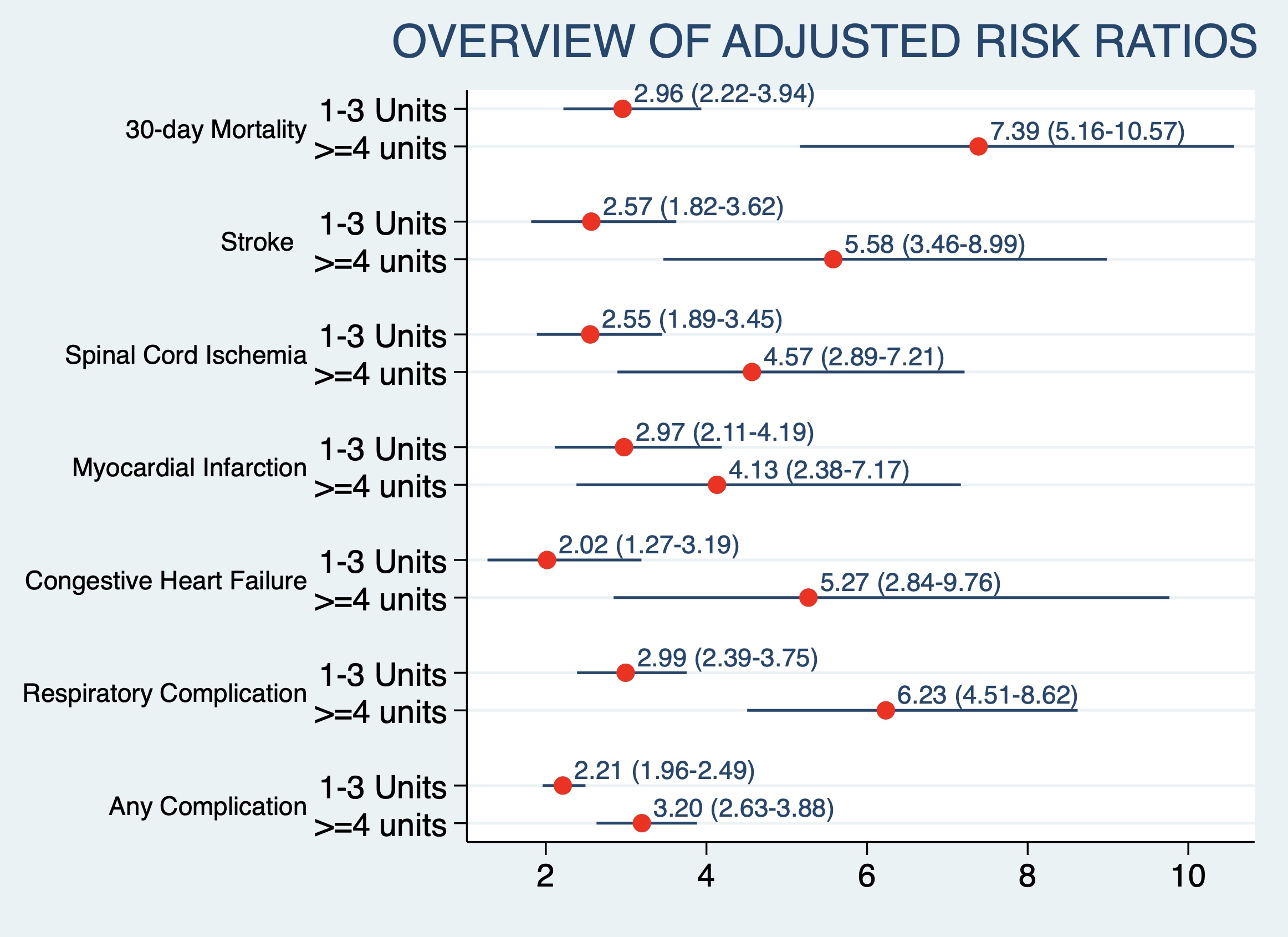PERIOPERATIVE BLOOD TRANSFUSION IS ASSOCIATED WITH WORSE 30 DAY MORTALITY ANDCOMPLICATIONS AFTER TEVAR
Daniel Willie-Permor, Sina Zarrintan, Ann C. Gaffey, Mahmoud B. Malas
University of California, San Diego, San Diego, CA
OBJECTIVES: Vascular surgery and in particular aortic surgery is nearly synonymous with blood transfusion requirements; however, studies examining the effects of perioperative transfusion during thoracic endovascular aortic repair (TEVAR) are limited. Using a large multi-center data, we aimed to study the impact of perioperative blood transfusion on 30-day mortality and complications after TEVAR.
METHODS: A total of 12,723 patients who underwent TEVAR were included in this retrospective study from the multi-center VQI cohort spanning 2010-2022. Excluded were emergent, post-traumatic, moderately/severely anemic(hemoglobin <10g/dl and <12g/dl for females and males respectively), open conversions, ruptured aneurysms, and patients with polycythemia. Primary outcomes were 30-day mortality and stroke. Secondary outcomes were post-op congestive heart failure (CHF), respiratory complications, spinal cord ischemia (SCI), myocardial ischemia(MI) and any post-op complications (composite variable). Poisson regression with robust variance was performed to determine the risk of post op outcomes comparing patients who received RBCs to those who did not.
RESULTS: Comparing patients without any transfusion (n= 11015), perioperative transfusion of 1-3 units was associated with nearly 3-fold increased risk of 30-day mortality( aRR 2.96 95% CI 2.22,3.94), 2.5 fold increased risk of stroke (aRR 2.57 95% CI 1.82,3.62), 2.5 fold increased risk of SCI (aRR 2.55 95% CI 1.89,3.45), 3-fold increased risk of MI (aRR 2.97 95% CI 2.11,4.19), 2-fold increased risk of heart failure (aRR 2.02 95% CI 1.27,3.19), 3-fold increased risk of respiratory complications (aRR 2.99 95% CI 2.39,3.75), and 2-fold increased risk of any post-op complications (aRR 2.21 95% CI 1.96,2.41). A higher rate of complications was observed with patients transfused 4 or more units.
CONCLUSION: In hemodynamically stable patients undergoing TEVAR for non-emergent and non-traumatic indications, transfusion of any amount peri-operatively is associated with worse 30-day mortality, stroke, SCI, MI , CHF and respiratory complications. A multi-disciplinary care approach is suggested for patients who receive any amount of RBCs peri-operatively for TEVAR to help improve outcomes. Future studies to understand the mechanisms of outcomes for transfused patients are needed.
Table I: Poisson regression analysis of post-operative outcomes
| Outcome | PERI-OP TRANSFUSIONAMOUNT | aRR (95% CI)* | P-value |
| 30-Day Mortality | No transfusion | Ref | Ref |
| 1-3 Units transfused | 2.96(2.22-3.94) | <0.001 | |
| 4 or more units transfused | 7.39(5.16-10.57) | <0.001 | |
| Any Post-op Complications | No transfusion | Ref | Ref |
| 1-3 Units transfused | 2.21(1.96-2.41) | <0.001 | |
| 4 or more units transfused | 3.20(2.63-3.88) | <0.001 | |
| Post-op Stroke | No transfusion | Ref | Ref |
| 1-3 Units transfused | 2.57(1.82-3.62) | <0.001 | |
| 4 or more units transfused | 5.58(3.46-8.99) | <0.001 | |
| Post-Op MI | No transfusion | Ref | Ref |
| 1-3 Units transfused | 2.97(2.11-4.19) | <0.001 | |
| 4 or more units transfused | 4.13(2.38-7.17) | <0.001 | |
| Post-op CHF | No transfusion | Ref | Ref |
| 1-3 Units transfused | 2.02(1.27-3.19) | 0.003 | |
| 4 or more units transfused | 5.27(2.84-9.76) | <0.001 | |
| Respiratory Complications | No transfusion | Ref | Ref |
| 1-3 Units transfused | 2.99(2.39-3.75) | <0.001 | |
| 4 or more units transfused | 6.23(4.51-8.62) | <0.001 | |
| Spinal Cord Ischemia | No transfusion | Ref | Ref |
| 1-3 Units transfused | 2.55(1.89-3.45) | <0.001 | |
| 4 or more units transfused | 4.57(2.89-7.21) | <0.001 |
*Adjusted for: blood loss, age, gender, ethnicity, race, CVD , CAD ,CHF, functional status, COPD ,diabetes, dialysis, hypertension , smoking ,CABG, PCI, PVI , aneurysm repair, creatinine, medications

Back to 2023 Display Posters


